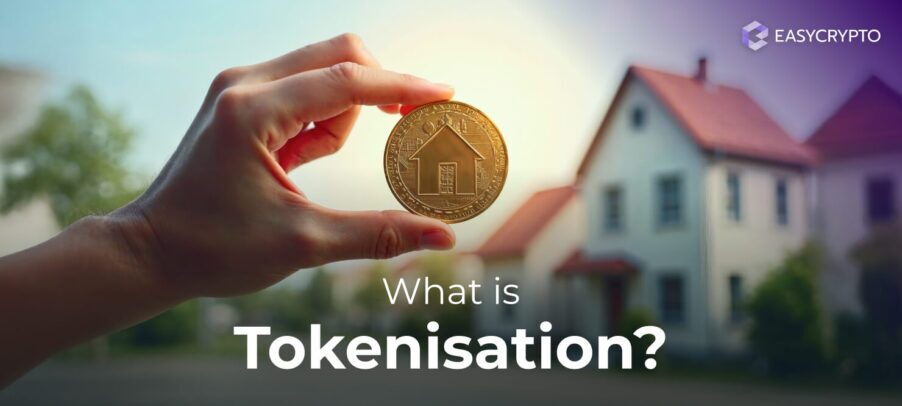What Gives Cryptocurrency its Value and Price?
Ever wondered how cryptocurrencies get their value? What gives a digital asset like crypto their price? Keep reading to learn more.


Recently, newsfeeds related to cryptocurrency are bombarded with all-time high price updates. Community mantras like “Buy the dip!” and “Hodl!” echo across social media channels. People normalise the skyrocketing prices of crypto coins, which have made many early adopters quite wealthy. So, what exactly gives cryptocurrency value?
“Is this for real?” This is the most commonly asked question. Though simple, this question bears a powerful set of questions and assumptions that are commonly held by onlookers who observe cautiously at the apparent mania:
- Are cryptocurrencies overrated and overpriced?
- What is the intrinsic value of a cryptocurrency?
- How is something that is unregulated trusted by large financial institutions?
These are very good questions that need to be asked more often. Therefore, this article attempts to look at cryptocurrencies under a proverbial critical thinking microscope and tries to answer these questions as thoroughly as possible.
What gives cryptocurrency its value?
All cryptocurrencies are valuable due to both their technological aspects and economical aspects. People tend to focus on one aspect more than the other, yet both technology and economics are powerful factors that ultimately determine the valuations for cryptocurrencies.
There seem to be two kinds of investors in the crypto space — those who believe in the potential of blockchain, the technology behind cryptocurrencies, and those who only speculate on the maximum future value of a crypto asset given the current external factors and the crypto’s intrinsic properties.
Putting faith in technology
Those who believe in the potential and utility of blockchain technology will focus on projects that resonate with them.
For example, some investors believe in Ripple’s (XRP) ability to mediate international payments between banks, where they can use XRP coin as a rapid and cheap medium of exchange, rather than through multiple intermediaries that connect disparate banking networks.
Many blockchains after the release of Ethereum in 2015 hold the promise of solving many problems that are inherent to centralized financial systems — systems that have been with us for thousands of years.
More on Ripple: Click here to learn more about Ripple (XRP).
Scarcity
Still, others believe in the value of staking one’s wealth on a scarce and subjectively valuable asset. A common example is bitcoin. Bitcoin’s inherent code does not allow the production of more than 21 million bitcoins.
New bitcoins are generated by rewarding miners with the most computing power among all other miners through a competition that lasts every 10 minutes. The value of this reward is halved every four years, making bitcoin incredibly scarce in the future, especially if the demand for them increases.
Investing in crypto is like investing in property
Most people consider cryptocurrencies as having similar properties to gold. Many cryptos were programmed to have a limited supply cap, and therefore can be used to hedge against monetary inflation.
Gold is also fungible, meaning that a person’s gram of gold is equal in value to another person’s gold of equal weight — a property that is shared by cryptos.
However, I’d like to think of crypto assets like land or property, and the way people value crypto assets is similar to how people value property. Although land is non-fungible, land prices are relatively similar within a location.
Not all locations offer the same price, just as not all crypto assets are valued equally. Land in a particular location can be more desirable due to the higher utility of the property (i.e. located strategically near city centers and public transport hubs).
Still, others only focus on the scarcity of land in a particular location, buying plots of land only to sell them to the highest bidder. This type of landowner may only be concerned with holding property until one earns capital gain in the future.
Related: Click here to learn the fundamental principles of cryptocurrency.
Intrinsic value in cryptocurrencies
First of all – what is intrinsic value? Well, intrinsic value is defined as the worth of an object derived from itself, regardless of external circumstances.
Although value always remains subjective to the eye of the beholder, it is hard to argue with the fact that anything which has a positive effect and various utility will have relatively greater value.
For example, gold has an intrinsic value, in that it can be used to make jewelry or metal alloys for various computer components. Water also has intrinsic value, in that it can be consumed for survival, used for irrigation, disposal, and even transport and power.
Do cryptocurrencies have intrinsic value?
All cryptocurrencies have intrinsic value in different forms. Bitcoin and its forks (i.e. Litecoin, Bitcoin Cash, Bitcoin Gold, Dash) and other cryptocurrencies that are mostly used as a medium of exchange have an intrinsic value deriving from their ability to be censorship-resistant.
Ethereum, Cardano and Polkadot have these intrinsic value and more. On all of these blockchains, many DeFi services can be implemented, such as loans, trading, private banking, and even gaming.
Fiat currencies, such as the US dollar has also has intrinsic value, although uncomparable to cryptocurrencies. Fiat currencies are valuable simply because governments says that it is legal tender. Beyond its use as medium of exchange, fiat currencies don’t really have any other function.
What gives cryptocurrency its intrinsic value, and why is it more valuable than fiat currency?
The intrinsic value of fiat currencies is found in their use as legal tender, meaning that it is the only medium of exchange with which citizens pay taxes. While the same can’t be said for cryptocurrencies, most of them offer what fiat currencies don’t offer — true scarcity.
Central bank policies are complicated. Attempts to balance a country’s economic output with the money supply often lead to the oversupply of money, which leads to devaluation of the currency and inflation. The supply of fiat currencies is technically infinite, while most cryptos have a supply cap.
This makes cryptocurrencies more valuable than fiat currencies. The same reason why gold is more valuable than water, even if life cannot exist without it.
Cryptocurrencies are also the only assets that have an increasing cost of production, thereby diminishing the rate of supply over time. Combining this factor with the network effect, it seems only natural that the price of bitcoin and other cryptos increase exponentially.
Related: Click here to take a closer look into Bitcoin mining.
What is the best crypto asset for you?
In order to find the most valuable crypto asset for you, you need to first know what you value.
Now, this is not a philosophical question, but a practical one.
If you are looking for a long-term store of value that can hedge against inflation, with potentially greater returns than gold or stock funds combined, bitcoin may be just for you.
If you appreciate the level of versatility that is offered by Ethereum’s smart contracts, then ETH or even ADA (Cardano’s currency) may be excellent choices.
Because the value of cryptocurrencies changes as new developments emerges over the crypto horizon, always do your research and follow good investing practices.
Where can you buy cryptocurrencies?
In an increasingly complex world, where people offer financial solutions left and right, it is easy to lose track of what is important — to preserve and grow wealth.
Investing in cryptocurrency can be made easy with Easy Crypto. Understand it, exchange some, and watch it grow over the coming months.

Start here: Click here to buy Bitcoin with Easy Crypto.
Share to
Stay curious and informed
Your info will be handled according to our Privacy Policy.
Make sure to follow our Twitter, Instagram, and YouTube channel to stay up-to-date with Easy Crypto!
Also, don’t forget to subscribe to our monthly newsletter to have the latest crypto insights, news, and updates delivered to our inbox.
Disclaimer: Information is current as at the date of publication. This is general information only and is not intended to be advice. Crypto is volatile, carries risk and the value can go up and down. Past performance is not an indicator of future returns. Please do your own research.
Last updated February 5, 2024





